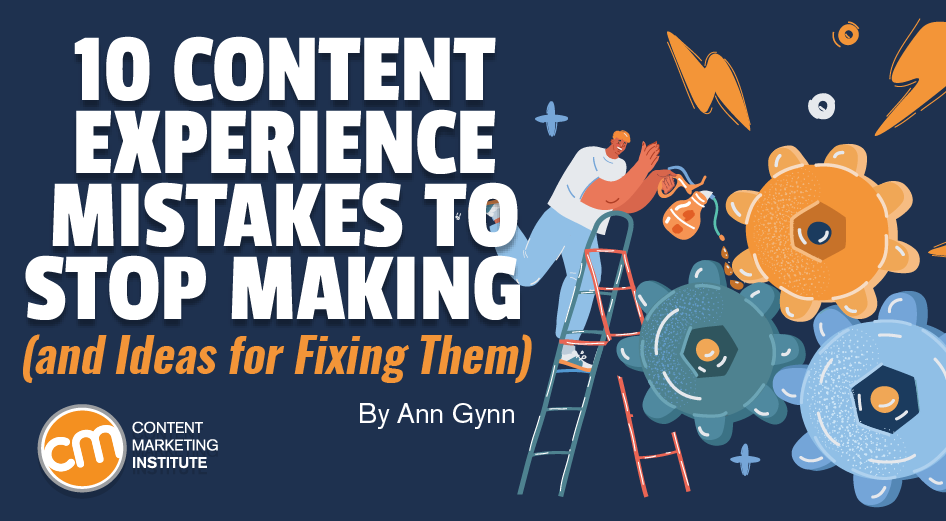MARKETING
10 Content Experience Mistakes To Stop Making (and Ideas for Fixing Them)

Can content be epic if the content experience isn’t?
Quality content is great, but it’s only one part of your audience’sexperience.
We asked the experts presenting at ContentTECH Summit this March what marketers are doing (or not doing) that prevents their audiences from having satisfying content experiences. Their answers encompass internal and external factors, from how content is created to how it’s delivered. (A few also shared what marketers are doing right, too.)
Here’s the set of mistakes the speakers notice content marketers making.
1. Delivering haphazardly
The challenge for every marketing team is that the customer’s content experience is often disjointed. Customers look at many different resources when they don’t get the answers they want. To stand out in that field, be the brand that asks customers what’s relevant to them and then serves up that content through a quiz, content filters, or even a chatbot. – Zontee Hou, director of strategy, Convince & Convert
Be the brand that asks customers what’s relevant to them, then serves up that #content, says @ZonteeHou via @CMIContent. #ContentTECH Click To Tweet
2. Not considering the whole content journey
Most marketers underestimate the work involved in creating an epic customer content experience, especially if you consider the experience to extend beyond one piece of content. Then it becomes more of a journey where you have to consider your visitors’ varying degrees of experience and knowledge. Their experiences will differ, and your content needs to account for that. – Jeff Coyle, co-founder and chief strategy officer, MarketMuse
Consider your visitors’ varying degrees of experience and knowledge. Make sure your #content accounts for that, says @Jeffrey_Coyle via @CMIContent. #ContentTECH Click To Tweet
3. Forgetting the real person
It’s easy to get caught up in the excitement of an epic content experience and lose sight of how the real live customer will interact with it. Adding in some persona research or customer feedback throughout the creation process can help you know if you’re on the right track. – Ali Orlando Wert, director, marketing strategy, SmartBug Media
Use #persona research or customer feedback during the #ContentCreation process to stay on the right track, says @AliOrlandoWert via @CMIContent. #ContentTECH Click To Tweet
4. Not investing in content personalization technology
When customer service sucks, nothing else matters. If customer service can’t address customers’ needs, it doesn’t matter how amazing the customer experience was up until then. Among the reasons customer service fails: 1. limited training of personnel, 2. limiting, pre-defined scripts, and 3. shortage of workers.
As a result, customer service is not personalized. If a company doesn’t have the technology for content personalization, generating content tailored to the needs of a specific customer becomes very expensive. As a result, many companies prefer to use generic content. However, generic content doesn’t address the needs of a specific customer in a specific situation, which translates to unhappy customers and potential losses in revenue. – Alex Masycheff, CEO, Intuillion
Generic #Content doesn’t address the needs of specific customers in specific situations, which translates to unhappy customers, says @DITAToo1 via @CMIContent. #ContentTECH Click To Tweet
5. Ignoring other internal content creators
Marketers fail to create epic customer content experiences by not including their organization’s other content creators in conversations. Often, writers closer to the product, such as technical writers or content designers, can highlight business values and customer stories that are unknown to marketers. What marketers get right is their ability to innovate on content appearance, language, or delivery, which is often stale when coming from other content teams. – Gavin Austin, principal tech writer, Salesforce
Marketers fail to create epic customer #content experiences when they don’t converse with their organization’s other content creators, says @GavinAustinSays via @CMIContent. #ContentTECH Click To Tweet
6. Treating visuals as an afterthought
While content marketers understand the power of visual content and are prioritizing visual content more than ever, those same marketers too often put quantity above quality. But 94% of first impressions are based entirely on how your content is designed. If you deliver content that feels rushed, cheap, or too stock-image heavy, you’re likely not giving your audience an epic customer content experience. – Amy Balliett, senior fellow of visual strategy, Material
If you deliver #content that feels rushed, cheap, or too stock-image heavy, you’re not giving your audience an epic customer experience, says @AmyBalliett via @CMIContent. #ContentTECH Click To Tweet
7. Discounting the content’s environment
The big miss here is they fail to focus on the actual experience. Creating great content is tough, but it’s not enough. We have to think about the environment in which it lives, the way it is structured to sit alongside other relevant content, and the way we compel people to engage in it or a strong CTA. – Randy Frisch, CEO and co-founder, Uberflip
Creating great #content isn’t enough. We have to think about how it sits with other relevant content and the way we compel people to engage with it, says @RandyFrisch via @CMIContent. #ContentTECH Click To Tweet
8. Letting ego drive
Marketers fail at creating epic content experiences when they allow selfishness or ego to override helpfulness. Awesome may get shared, but helpful gets bought. When content marketers put the buyer first, they create CRAP (concise, relevant, and persuasive) content that leads to conversations that convert to customers. – Tom Martin, president, Converse Digital
Marketers fail at creating epic #content experiences when they allow selfishness or ego to override helpfulness, says @TomMartin via @CMIContent. #ContentTECH Click To Tweet
9. Ignoring real customers in content planning
One of the biggest fails we see is that marketers don’t fully understand their audience’s content needs. For example, running persona workshops for their internal audiences with zero customers involved. This is a missed opportunity and leads to misdirected and wasted content efforts and poor experiences.
Once you really know your customers and what they want, the move from good to epic experiences involves detailed journey mapping and identifying the most useful, memorable, and evergreen content experiences you can provide along the way aligned to what they want. It might be an FAQ answering all the questions they have, a how-to video, a fun interactive quiz, a blog, or any other selection of content solutions.
On a positive note, more marketers are now working closely with their CIOs to develop the tech stack needed to support great customer content experiences. Smart marketers are also upskilling in the tools to improve experience delivery. Marketing automation, content attribution modeling, social listening, and interactive content solutions are just some of the technologies that can help to get you from good to epic. – Karen Hesse, founder and CEO, 256
One of the biggest fails we see is that marketers don’t fully understand their audience’s #content needs, says @256media via @CMIContent. #ContentTECH Click To Tweet
10. Treating content as product promotion
A fail is not understanding that pitching your product is never considered content. On the positive side, marketers are using internal resources to communicate with customers. – Rob Walch, vice president of Libsyn enterprise and platform partnerships, Libsyn
Pitching your product is never considered #content, says @podcast411 via @CMIContent. #ContentTECH Click To Tweet
Create epic experiences
Here’s the TL;DR version of the advice from these ContentTECH Summit presenters: Never forget to put the customer at the forefront of what you do – planning, creating, distributing, and evolving your content marketing. That’s the only way to create an epic content experience.
Never forget to put the customer at the forefront of what you do, says @AnnGynn via @CMIContent #ContentTECH speakers. Click To Tweet
Cover image by Joseph Kalinowski/Content Marketing Institute



















You must be logged in to post a comment Login